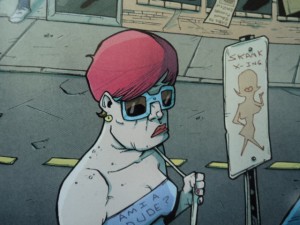I’m writing this essay because I feel disgusted and betrayed. My name is Rachel Stevens, and I am a transwoman. I live my life in fear because of it, and I have a devil of a time finding fictional works to take in that aren’t actively hateful towards people like me. Unfortunately, I have to remove Chew from the list of comics that I can read and enjoy without being actively insulted.

Starting from the top, John Layman and Rob Guillory’s Chew is a generally wonderful indie book published by Image Comics. It’s about an Asian-American detective named Tony Chu who’s made an FDA agent after the avian flu kills millions and chicken is made contraband. Tony Chu is a cibopath — he takes in memories of everything he eats, except for beets. This comes in very handy for his job — he often winds up taking a bite out of a dead body during the course of the case to find out who murdered the victim.
There’s an absolutely enormous cast of characters at this point, all with their own different relationships to Tony. It’s pretty diverse too — Layman has stated in interviews that he doesn’t specify the race of most characters in his scripts, and Guillory typically winds up drawing non-white people for the cast. The art is charming but grotesque, making some of the grosser moments more palatable. The writing is snappy, and the character moments and world building are top notch. The fact that the work is actively transmisogynistic in both its writing and art, and has been for years, however, needs to be noted.

There are three perfect examples of the transmisogyny in Chew. The first is Tony’s sibling Harold, who I will refer to by their birth name, as that is what they are referred to by the narrative. Harold is drawn as an obviously masculine woman with facial stubble. Their design was generally a contrast to the other women of Chew, who have obscenely curvy proportions as part of Guillory’s cartoonish style. The character has been referred to exclusively with male pronouns, but their “stage name” of Miso Honey is twice brought up in captions as a joke. In their second appearance in the seventh trade paperback of Chew, they were referred to as Tony’s “brother/sister.” When the character was first introduced in volume three of Chew, I believed that Layman and Guillory were trying to be inclusive but were ignorant. That became harder to believe as time passed. I winced at Harold’s appearances, but I continued to read the series.

In volume six of Chew, one of the antagonists appears to be a woman using food related superpowers of her own to disguise people and use it for crimes. It turns out that the woman who could make food into a mask was murdered by the antagonist, who used the woman’s stockpile of materials to use for disguising themselves. The antagonist turned out to be a man in disguise, and a decent amount of page space was dedicated to the reveal in the form of the antagonist’s appearance becoming more and more masculine, while still dressed in feminine clothing. I grit my teeth, but I kept going. The characters and story were compelling, even though I knew that stereotypical imagery linked to transwomen was being utilized for humor consistently at this point.
The final straw was in volume seven of Chew. I slammed the trade paperback shut and haven’t read past the part that made me give up on the series forever. As mentioned in the above interview, Guillory is responsible for much of the tone of the series, especially in the form of sight gags. One of the “gags” was a masculine woman walking near a sign that said “Skank X-ING” while wearing a shirt that said “Am I A Dude?” At this point, it became clear that both writer and artist were, if not merely ignorant, active bigots that used insulting depictions of transwomen for a laugh. The depictions of Harold and the antagonist from volume 6 could have been Guillory following a script, but the last proved that even he wasn’t free from his own brand of offense.

I shouldn’t have to say that not all transwomen appear masculine; I shouldn’t have to say that it shouldn’t matter even if they did. The fact remains that Chew insults transwomen by resorting to stereotypes just for the sake of cheap jokes, and while the examples listed here are the most prominent, they aren’t the only ones. The creative team of Layman and Guillory acts like masculine people in feminine dress is the height of comedy, as if it hasn’t been decades since Monty Python. I’m certain that defenders of Chew would love to point out that it isn’t just transwomen they make fun of; they also make fun of the elderly and the overweight, and they sexualize women throughout the series.
I hate that even though Chew is racially diverse, even though there are competent women portrayed throughout the series, even though one of the main cast is bisexual and not a stereotype, the only transgender people are caricatures. And there aren’t any transmen in the series, at least as far as I’ve read. Perhaps the series improves past that point, and the creative team makes up for their past offenses.
Until that happens, however, I’m done.
